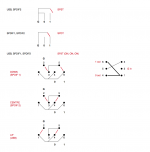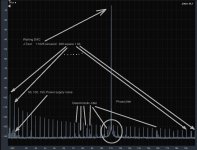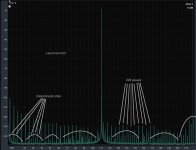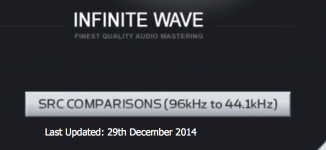Too soon, you should have scrolled down to the images
OK, a little further down:
"The waveform (ringing) to the left (pre) and right (post) of the center of the pulse are filter associated flaws." contnuing with "We need to find the best compromise. If there are certain flaws at -170db, I'm not really sure, if that
matters anymore."
Hes not really sure but are thinking about it - LOL.
Thoses ringing are the perfect result of the system used and a testimony that the PCM system does its thing. Textbook and if you tweak the system to make them go away tyou have distorted it.
It is obvious that this person is only guessing or hallucinating. Allow me to laugh.
Sorry...
//
So the DAC seems to sound better with 44.1 when it is upsampled.
Next week I'm back home and I can start with this nice DAC
In the meantime I did some research about resamplers and filters:
Here's an interesting article at soundcheck site about resamplers and ringing artifacts.
One of the best resamplers is SoX, it's open source and also available as plugin for foobar.
Regards,
Danny
Something good with source code, that's something I can use.... Anybody second SoX ?
Comparative jitter measures.
Buffalo DAC with Amanero, Weiliang DAC with XMOS Weiliang, Dam1021 2% with Amanero.
The measures are the minimum noise on my Motu Ultralite MK3 . The Dam1021 probably better measure.
I used single transformer. Dam1021 has very good Power suply. In my opinion no need construction of external power for improvement.
Have better fase jitter. I think the digital filter is very bad.
Very interesting
What is the "strategy" if the commercial has already an output traffo with its spidf ? We keep just the 330 ohms shunt and the 1.2 V PS layout ? (believe I already asked that but had a silence !)
You can then connect it GND to GND, Signal to where the trafo + connects, but with a series capacitors, any value around 0.1 uF.
The important when using the LVDS receiver is that it need to be biased around 1.25V as the common mode input range is 0-2.5V.
Something good with source code, that's something I can use.... Anybody second SoX ?
Plenty of happy SoX users in sourceforge.
Here's a link to a compare tool
Last edited:
I haven't gotten around to testing my Dam1021 yet, but I have had similar observations with another DAC/DSP.
I have a WAF-audio Najda which I use for my 3 way active system. I started out with running the dSP fitlers at 48 khz, the sound was ok but nothing special. I then tried 96 khz which was a great improvment even though almost all my material is 16 bit/44.1 khz.
I wonder if it is the same issue that is present with the Dam1021.
I am using winamp with a FFSoX Player 2 plugin to upsample 24 bit/176.4 khz.
I have a WAF-audio Najda which I use for my 3 way active system. I started out with running the dSP fitlers at 48 khz, the sound was ok but nothing special. I then tried 96 khz which was a great improvment even though almost all my material is 16 bit/44.1 khz.
I wonder if it is the same issue that is present with the Dam1021.
I am using winamp with a FFSoX Player 2 plugin to upsample 24 bit/176.4 khz.
DIY your own binary coded dip switches.
Looks like 4 position BCD switch isn't available anywhere. They are at least 10 positions. I'd hate dangling null positions on the switch. So here is how to DIY your own binary coded switch with readily available regular ones. Bonus is you get a big tough switch to mount on your chassis.
First one is what I'll use for switching between USB and Toslink. Requires a SPST.
Second one is an example to switch between Toslink and AES. Requires a SPDT.
Third one is for all USB, Toslink and AES inputs. Requires a SP3T (http://www.farnell.com/datasheets/1784503.pdf).
Blame any errors on the 4th glass of Ardbeg. See you next weekend. I'ts been a pleasure...
It should be Code 12 BCD version then.
Looks like 4 position BCD switch isn't available anywhere. They are at least 10 positions. I'd hate dangling null positions on the switch. So here is how to DIY your own binary coded switch with readily available regular ones. Bonus is you get a big tough switch to mount on your chassis.
First one is what I'll use for switching between USB and Toslink. Requires a SPST.
Second one is an example to switch between Toslink and AES. Requires a SPDT.
Third one is for all USB, Toslink and AES inputs. Requires a SP3T (http://www.farnell.com/datasheets/1784503.pdf).
Blame any errors on the 4th glass of Ardbeg. See you next weekend. I'ts been a pleasure...
Attachments
I will try to explain the Jitter meassure. Get to compare the best meassure I have: Weiliang DAC, Xmos, and 0.1 ppm clock. The ground is aleatory jitter (Dam1021 have 3 dB better ¡buffer work!)
Phase Jitter is the base width of 11 kHz tone. (Dam1021 is better).
The weiliang deterministic jitter appears in different DAC measures, is Jitter of measure equipment: Motu Ultralite MK3.
- The theoretical 229 Hz. square response is 229 Hz. and multiples. They are decreasing. In the Dam1021 the multiples deform from 10 Khz. to 22,05 Kz.
- Deterministic jitter appears in the middle of square signal: 342.5 Hz and multiples.
Both Dam1021 problems increase with frequency similar to sinc function, I think it is aliasing problem of digital filter.
That explains it sound better at higher sampling rates because filter aliasing problems appear Appear at higher frequencies less audible.
Phase Jitter is the base width of 11 kHz tone. (Dam1021 is better).
The weiliang deterministic jitter appears in different DAC measures, is Jitter of measure equipment: Motu Ultralite MK3.
- The theoretical 229 Hz. square response is 229 Hz. and multiples. They are decreasing. In the Dam1021 the multiples deform from 10 Khz. to 22,05 Kz.
- Deterministic jitter appears in the middle of square signal: 342.5 Hz and multiples.
Both Dam1021 problems increase with frequency similar to sinc function, I think it is aliasing problem of digital filter.
That explains it sound better at higher sampling rates because filter aliasing problems appear Appear at higher frequencies less audible.
Attachments
Last edited:
Enlighten me then.
I'm searching for a good upsampler/filter and the SoX seems to be very good from what I've read.
I'm sure SOX is OK for what it does. But I don't agree with the analysis around it in the article.
I certenly hope that Sören can provide a basic textbook filter as I dont belive there is any hidden gems in special filters.
In Nyquist and the Sinc I trust.
//
Very interestingSounds like you're using an external audio interface for testing, so what software are you using ? I'm still trying to find good software for audio measurement using an external audio interface, have tried most and haven't really been happy with any....
Is Smaartlive
http://www.rationalacoustics.com
Hello Soren,
My 2 cents analysis: the dam's sound quality likely suffers at low Fs (44.1kHz) because the analog reconstruction filter is at far too high a frequency, especially for a NOS DAC. Oversampling should improve things, upsampling too. Oversampling should be relatively easy to implement, I would not recommend upsampling in the fpga, devil is in the details for upsampling. There are software upsamplers that can be used to evaluate sound improvement, if any. I can easily upsample a file (matlab, scilab). For DAM, you could (should) implement simple filters in the DAC. Daring dyiers could also build an analog LPF with a lower corner frequency and listen for improvements.
On another note: regarding the volume control, my vote goes for a maximum of 0dB as the max. The amplifier can do the required amplification. I may be old school, but I doubt more than 1% of people build your dac are audiophiles and use youtube for content for serious listening.
Finally, thanks for all your efforts, much appreciated.
My 2 cents analysis: the dam's sound quality likely suffers at low Fs (44.1kHz) because the analog reconstruction filter is at far too high a frequency, especially for a NOS DAC. Oversampling should improve things, upsampling too. Oversampling should be relatively easy to implement, I would not recommend upsampling in the fpga, devil is in the details for upsampling. There are software upsamplers that can be used to evaluate sound improvement, if any. I can easily upsample a file (matlab, scilab). For DAM, you could (should) implement simple filters in the DAC. Daring dyiers could also build an analog LPF with a lower corner frequency and listen for improvements.
On another note: regarding the volume control, my vote goes for a maximum of 0dB as the max. The amplifier can do the required amplification. I may be old school, but I doubt more than 1% of people build your dac are audiophiles and use youtube for content for serious listening.
Finally, thanks for all your efforts, much appreciated.
Both Dam1021 problems increase with frequency similar to sinc function, I think it is aliasing problem of digital filter.
That explains it sound better at higher sampling rates because filter aliasing problems appear Appear at higher frequencies less audible.
I agree. By using a higher fs, one rejects folding frequencies at higher freqs and this could be compensated easily with oversampling/upsampling or higher fs material. Besides, as i just wrote to Soren, the reconstruction filter is too high a frequency for fs<50kHz to help with the current filering scheme.
As far as i know best one;
Finalcd Downloads
and
İZotope Adv RX4
https://www.izotope.com/support/kb/index.php/kb/article/321-SRC_Licensing
Propbably Izotope SRC licensing is so expensive but its worth to try liscensing finalcd algorithm.
@Soren: You can directly contact with Tom Browne (enquiries@sonicillusions.co.uk) he has great knowledge and can help you.
Last edited:
I hope there will only be n* SRC. I.e. 44,1 -> 96 shall never happen.
Why would anyone do that ?
Btw - Sören, what oversampling is present in the current FW for 16/44,1 source material?
//
http://www.diyaudio.com/forums/vend...magnitude-24-bit-384-khz-129.html#post4212417
I know there are so many posts....
I second SoX...
Here are some links from Digital HW designer John Swenson on digital filters in general and using SoX to generate the filters he used in the DAC he designed for Bottlehead:
Upsampling Impressions
Here's the rundown on the DAC
Taking orders
Taking orders
Taking orders
Taking orders
I both second SoX as an upsampling filter generator AND John's thoughts as a starting point for at least one direction for an optimized filter search.
Greg in Mississippi
Something good with source code, that's something I can use.... Anybody second SoX ?
Here are some links from Digital HW designer John Swenson on digital filters in general and using SoX to generate the filters he used in the DAC he designed for Bottlehead:
Upsampling Impressions
Here's the rundown on the DAC
Taking orders
Taking orders
Taking orders
Taking orders
I both second SoX as an upsampling filter generator AND John's thoughts as a starting point for at least one direction for an optimized filter search.
Greg in Mississippi
Last edited:
I agree. If resampling, only 44,1-> 88.2 48-> 96. The other frequency, original format.I hope there will only be n* SRC. I.e. 44,1 -> 96 shall never happen.
//
With spline interpolation would be ideal and simple. and not use iZotope or SOX algorithms. a lot of calculations and.
44,1->96 is bad jitter and bad sound. I have measured and listening boot algorithm.
And focus on improving the digital filter so that there is no aliasing.
Last edited:
Why would anyone do that ?
http://www.diyaudio.com/forums/vend...magnitude-24-bit-384-khz-129.html#post4212417
I know there are so many posts....
Yes indeed why? Maybe I interpret the attachment wrongly...
Post linking doesnt work (for me?). Please state post #
Attachments
- Home
- Vendor's Bazaar
- Reference DAC Module - Discrete R-2R Sign Magnitude 24 bit 384 KHz



